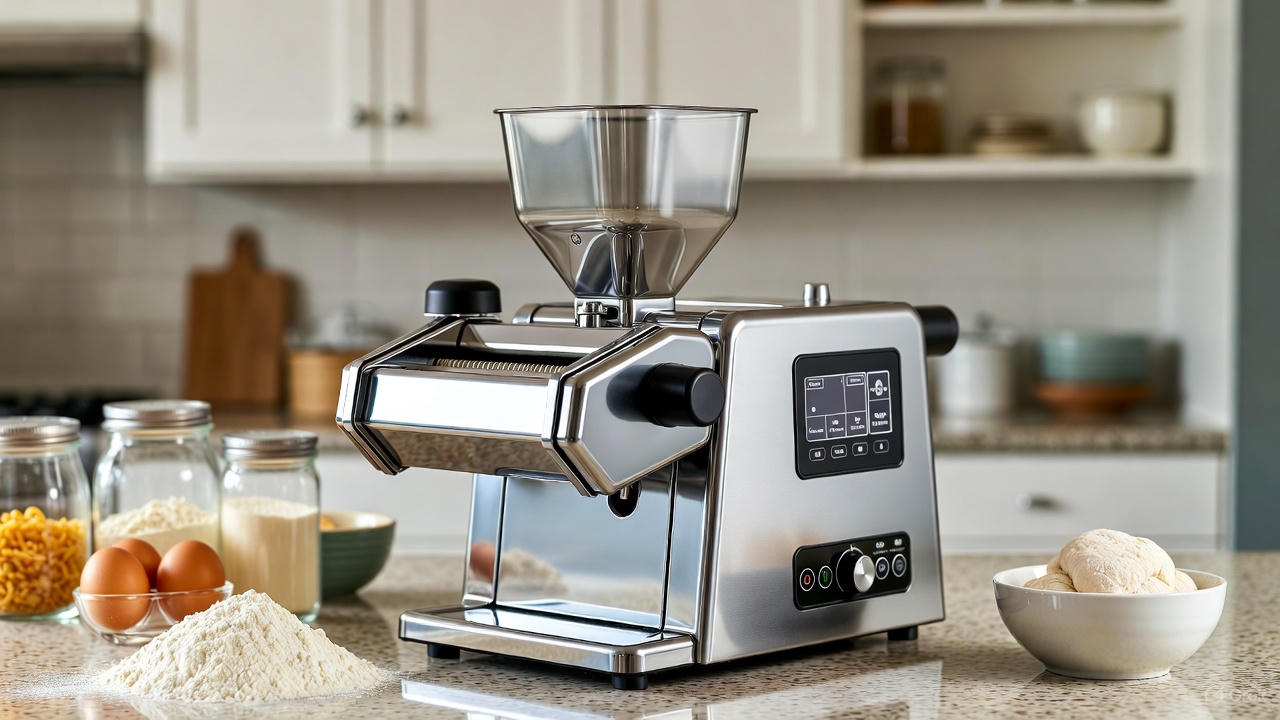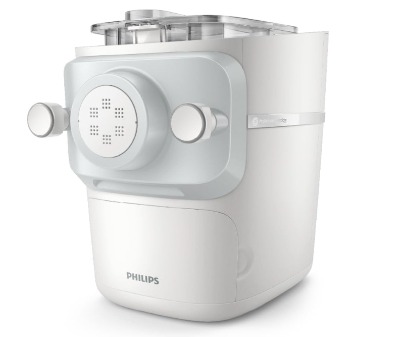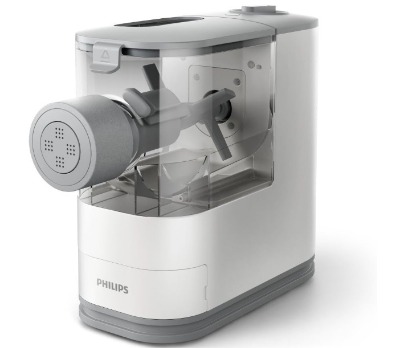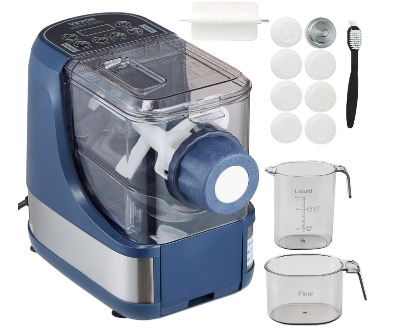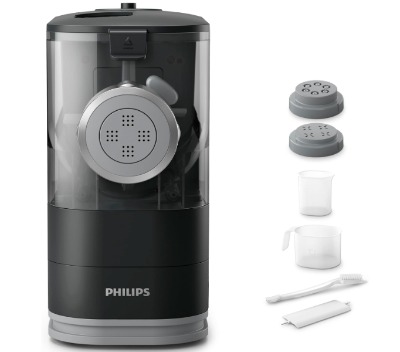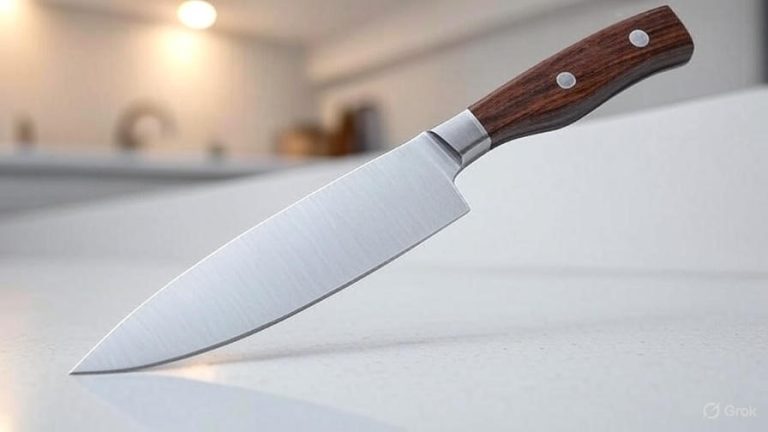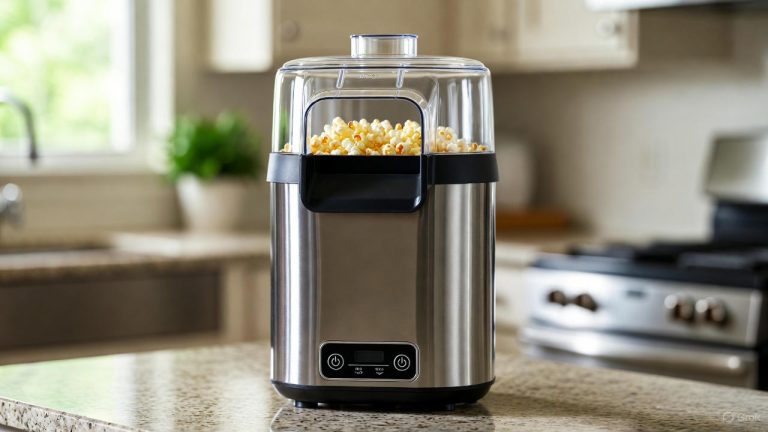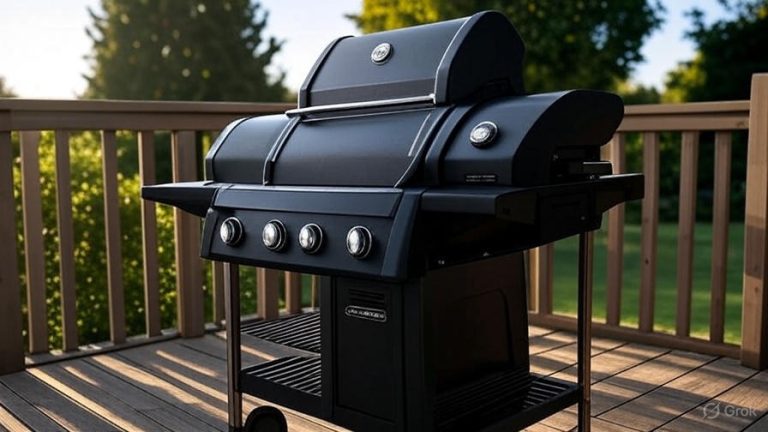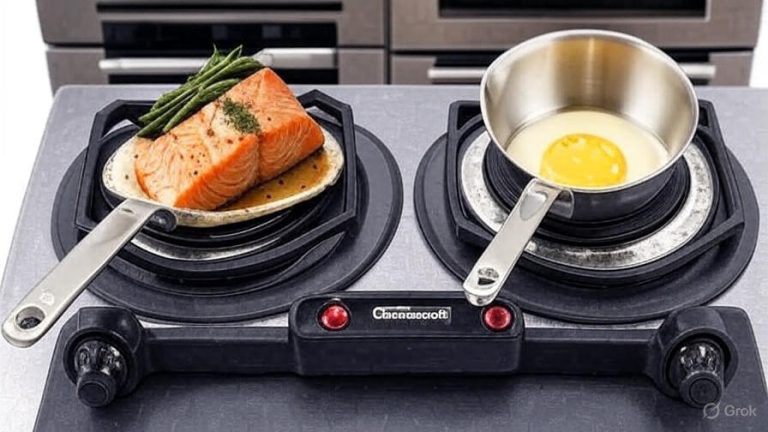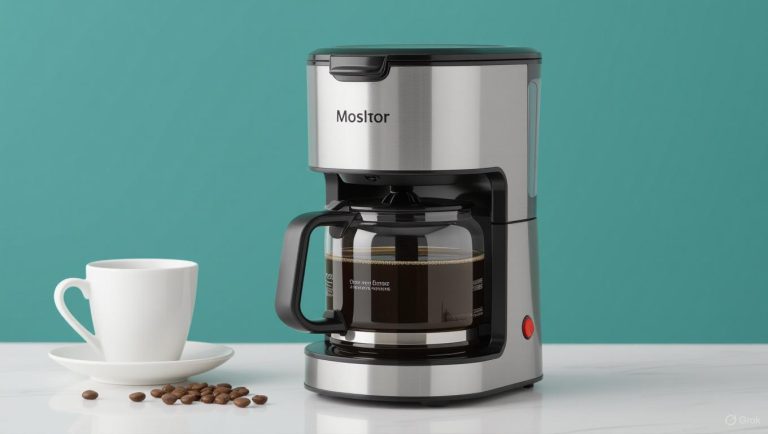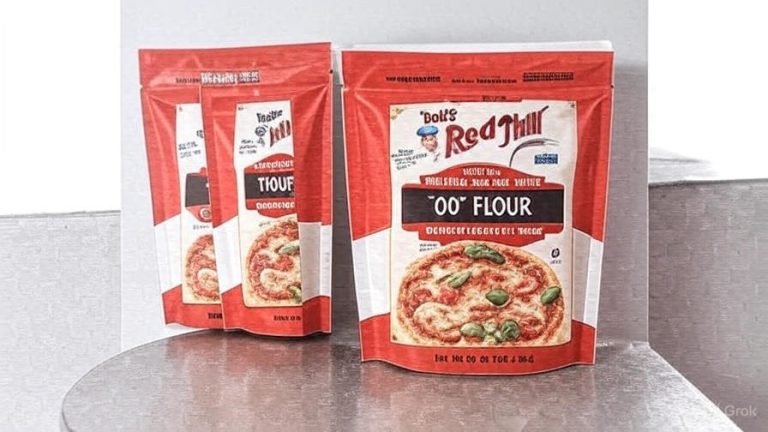5 Best Automatic Pasta Maker In 2025
Making fresh pasta at home sounds like a dream, but the traditional method demands time, effort, and quite a bit of mess. Automatic pasta makers have changed the game entirely. These innovative kitchen appliances take the hard work out of pasta making, allowing you to create restaurant-quality noodles right in your own kitchen.
The beauty of an automatic pasta maker lies in its simplicity. You add your ingredients, press a button, and watch as perfectly formed pasta emerges from the machine. No more rolling dough by hand or wrestling with manual cranks. This technology brings artisanal pasta making into the modern age.
Today’s market offers several excellent options, each with unique features and capabilities. From budget-friendly models to high-end machines packed with smart technology, there’s an automatic pasta maker for every home cook. This comprehensive guide examines the top five automatic pasta makers available, helping you find the perfect match for your kitchen.
Understanding Automatic Pasta Makers
An automatic pasta maker handles the entire process from mixing to extrusion. Unlike traditional pasta machines that require manual operation, these electric devices do all the heavy lifting. You simply add flour and liquid, and the machine mixes, kneads, and extrudes the dough through specially designed discs.
The process begins with the mixing chamber where ingredients combine into a consistent dough. The machine then pushes this dough through shaping discs that create different pasta styles. From spaghetti to fettuccine, from penne to lasagna sheets, these versatile tools can produce virtually any pasta shape you desire.
Most automatic pasta makers come with multiple shaping discs, giving you variety right out of the box. The entire process typically takes 10 to 20 minutes from start to finish, making fresh pasta a realistic option even on busy weeknights.
Key Features to Consider
When shopping for an automatic pasta maker, several factors should guide your decision. Power matters because stronger motors handle thicker doughs more effectively. Look for machines with at least 150 watts for reliable performance.
Capacity determines how much pasta you can make in one batch. Family-sized machines can handle 500 grams or more of flour, producing enough pasta for multiple servings. Smaller households might prefer compact models with reduced capacity.
The number and variety of shaping discs directly impact your pasta-making possibilities. Basic models include three to four standard shapes, while premium options offer eight or more discs for maximum creativity. Some manufacturers sell additional discs separately, allowing you to expand your collection over time.
Ease of cleaning can make or break your pasta-making experience. Machines with dishwasher-safe components save significant time and effort. Built-in cleaning modes that push remaining dough through the system also simplify maintenance.
Smart features like apps, recipe databases, and pre-programmed settings add convenience, though they’re not essential for great results. Consider whether these extras justify any additional cost based on your cooking style.
Product Reviews
1. Philips 7000 Series Pasta Maker (HR2660/03)
The Philips 7000 Series represents the pinnacle of automatic pasta making technology. This premium appliance combines powerful performance with intelligent features that take the guesswork out of creating perfect pasta every time.
Product Description
The HR2660/03 model features ProExtrude Technology, which ensures consistent pressure throughout the extrusion process. This results in pasta with professional texture and bite. The 150-watt motor provides ample power for any dough consistency, from delicate egg noodles to hearty whole wheat pasta.
Perfect Mixing Technology automatically adjusts the kneading process based on the ingredients you use. The machine senses the dough consistency and adapts accordingly, virtually eliminating failed batches due to improper hydration or mixing.
This model includes eight shaping discs: spaghetti, penne, fettuccine, lasagne, angel hair, tagliatelle, pappardelle, and one custom disc. The variety allows you to create complete Italian meals from appetizers to main courses.
The HomeID app connects to your pasta maker via Bluetooth, offering over 25 recipes with step-by-step guidance. The app can also create custom recipes based on the ingredients you have on hand. It tracks your pasta-making history and suggests new combinations to try.
With capacity for up to eight portions per batch, this machine handles family dinners and small gatherings with ease. The automated cleaning program flushes remaining dough from the system, making cleanup significantly faster.
Pros
- ProExtrude Technology delivers consistently excellent texture
- Perfect Mixing Technology adapts to different flour types automatically
- Eight shaping discs provide impressive variety
- HomeID app offers guidance and recipe inspiration
- Large capacity suitable for families
- Automated cleaning function saves time
- Premium build quality ensures longevity
Cons
- Higher price point than entry-level models
- Requires Bluetooth-enabled device for app features
- Larger footprint demands counter space
- App connectivity might be unnecessary for simple recipes
The Philips 7000 Series suits serious home cooks who want the best possible results with minimal effort. The investment pays off in consistent quality and long-term reliability.
2. Philips Viva Collection Compact Pasta Maker (HR2370/05)
The Viva Collection offers an excellent entry point into automatic pasta making. This compact machine delivers authentic results without overwhelming features or complicated operation.
Product Description
This streamlined pasta maker focuses on core functionality. The machine includes three classic shaping discs: spaghetti, penne, and fettuccine. These cover the most popular pasta styles, making this model ideal for those who prefer traditional shapes.
The fully automatic operation requires minimal input. Add your ingredients, select your shape, and press start. The machine handles mixing, kneading, and extruding without any manual intervention. The entire process completes in approximately 15 minutes.
The compact design makes this pasta maker apartment-friendly. It occupies minimal counter space and stores easily in cabinets when not in use. Despite its small size, the machine produces enough pasta for four servings per batch.
The included recipe book provides inspiration and guidance for beginners. It covers basic pasta dough recipes plus instructions for creating various sauces and complete meals. The recipes are tested and tailored specifically to this machine’s capabilities.
White housing gives the appliance a clean, modern appearance that complements most kitchen aesthetics. The simple control panel features clearly labeled buttons that anyone can understand at a glance.
Pros
- Compact size perfect for smaller kitchens
- Straightforward operation with minimal learning curve
- Three essential pasta shapes included
- Recipe book helps beginners get started
- Affordable price point
- Fully automatic mixing and extrusion
- Easy to store when not in use
Cons
- Only three shaping discs limit variety
- Smaller capacity than premium models
- No smart features or app connectivity
- Basic design lacks advanced mixing technology
This model serves home cooks who want fresh pasta without complexity or expense. It’s perfect for testing whether automatic pasta making fits your lifestyle before investing in more advanced equipment.
3. EMERIL LAGASSE Pasta & Beyond
Celebrity chef Emeril Lagasse brings his culinary expertise to this well-designed automatic pasta maker. The machine balances performance with value, offering features typically found in more expensive models.
Product Description
The Pasta & Beyond includes eight pasta shaping discs right in the box. This generous assortment rivals premium models at a more accessible price point. The discs create spaghetti, fettuccine, penne, lasagna sheets, angel hair, small and large macaroni, and flat noodles.
The automatic system handles the complete pasta-making process. Pour in your flour and liquid, select your desired shape, and let the machine work. Internal sensors monitor the mixing process, ensuring proper dough consistency before extrusion begins.
The sleek black housing adds a professional look to your kitchen. The compact footprint means this machine won’t dominate your counter space, yet it’s substantial enough to feel sturdy and well-built during operation.
Cleanup proves straightforward thanks to removable components. The mixing chamber, shaping discs, and other parts that contact food can be washed separately. The machine includes a cleaning tool specifically designed to remove dough from the shaping discs.
The motor provides sufficient power for various dough types, from traditional semolina to alternative flours like whole wheat or gluten-free blends. This versatility appeals to households with dietary restrictions or adventurous cooks who enjoy experimenting.
Pros
- Eight shaping discs provide excellent variety
- Attractive design with celebrity chef branding
- Handles alternative flours effectively
- Removable components simplify cleaning
- Automatic operation from mixing to extrusion
- Good value for the feature set
- Compact yet sturdy construction
Cons
- No app connectivity or smart features
- Manual monitoring recommended for best results
- Black finish shows dust and fingerprints
- Some users report needing to adjust water amounts from recipes
The EMERIL LAGASSE Pasta & Beyond targets cooks who want versatility and brand reliability without paying premium prices. It’s an excellent middle-ground option that delivers consistent results.
4. VEVOR Electric Pasta Maker
VEVOR has built a reputation for producing reliable kitchen equipment at competitive prices. Their electric pasta maker continues this tradition, packing impressive features into an affordable package.
Product Description
This 150-watt pasta maker offers the power needed for consistent performance. The motor handles standard and alternative flours without strain, maintaining steady operation throughout the extrusion process.
Eight pasta shaping discs come included, giving you creative freedom from day one. The shapes cover Italian classics and Asian noodles, expanding your culinary repertoire beyond traditional pasta dishes. This versatility makes the machine useful for multiple cuisines.
Four intelligent modes differentiate this model from simpler competitors. The modes adjust mixing time, kneading intensity, and extrusion speed based on the pasta type you’re making. This automation helps beginners achieve professional results without deep pasta-making knowledge.
The 500-gram flour capacity makes this machine suitable for families. A single batch produces enough pasta for four to six servings, depending on appetites and accompaniments. This capacity hits the sweet spot for most households.
Measuring cups simplify the ingredient adding process. The included cups are calibrated specifically for this machine, taking the guesswork out of proper flour-to-liquid ratios. This attention to detail helps ensure successful batches every time.
The cleaning brush fits perfectly into the shaping discs, removing stuck dough efficiently. This specialized tool saves frustration and time, making post-cooking cleanup less of a chore.
Pros
- Four intelligent modes optimize results automatically
- 500-gram capacity suitable for families
- Eight shaping discs provide variety
- 150-watt motor handles different flour types
- Included measuring cups ensure accuracy
- Specialized cleaning brush simplifies maintenance
- Excellent value for money
Cons
- Build quality not quite at premium level
- Instructions could be more detailed
- No smart features or connectivity
- Some plastic components feel less substantial
The VEVOR Electric Pasta Maker appeals to budget-conscious buyers who refuse to sacrifice features. It’s ideal for families wanting to explore fresh pasta without significant financial commitment.
5. Philips Viva Collection Compact Pasta Maker (HR2371/05)
The black version of Philips’ compact pasta maker offers the same reliable performance as its white counterpart with a different aesthetic. This model suits those who prefer darker appliances in their kitchen.
Product Description
This machine mirrors the functionality of the HR2370/05 model while sporting a sophisticated black finish. The color choice allows you to match existing kitchen appliances or create visual contrast, depending on your design preferences.
Three classic shaping discs come standard: spaghetti, penne, and fettuccine. These fundamental shapes form the foundation of countless pasta dishes, from simple butter-and-garlic preparations to complex layered casseroles. For many home cooks, these three options provide all the variety needed.
The fully automatic operation removes complexity from pasta making. The machine mixes ingredients into cohesive dough, kneads it to the proper consistency, and extrudes it through your chosen shaping disc. You’re free to prep sauces or side dishes while the pasta maker works.
The included recipe book contains tried-and-tested formulas for success. Recipes go beyond basic pasta dough, offering creative filling ideas for stuffed pasta and sauce suggestions that complement each shape. The book helps you develop confidence and skill in pasta preparation.
Compact dimensions make this pasta maker practical for apartments, small homes, or kitchens with limited counter space. The machine slides into cabinets easily, staying out of sight when not in use. Despite its small size, it produces enough fresh pasta for a family meal.
The straightforward control panel features intuitive buttons that require no manual to understand. This user-friendly design means anyone in the household can make pasta, not just the primary cook.
Pros
- Sleek black finish for modern kitchens
- Compact footprint saves counter space
- Three essential shapes cover most needs
- Recipe book provides practical guidance
- Fully automatic for hands-free operation
- Simple controls anyone can master
- Affordable entry into fresh pasta making
Cons
- Limited to three pasta shapes
- Smaller capacity than family-sized models
- Black finish may show water spots
- No advanced features or connectivity
This model works perfectly for singles, couples, or small families who want fresh pasta without fuss. The black color option gives you aesthetic flexibility while maintaining all the practical benefits of the white version.
Making Perfect Pasta: Tips and Techniques
Success with automatic pasta makers depends partly on the machine and partly on your technique. Start with quality ingredients because they directly impact the final product. Use fine-grind semolina flour or tipo 00 flour for authentic Italian texture. All-purpose flour works in a pinch but produces slightly different results.
Accurate measurements matter more than you might think. Too much liquid creates sticky dough that clogs the machine. Too little liquid results in crumbly pasta that breaks apart. Use the measuring cups provided with your machine or invest in a kitchen scale for precision.
Room temperature ingredients mix more evenly than cold ones. Take eggs out of the refrigerator 30 minutes before making pasta. This simple step prevents temperature-related mixing issues.
Don’t rush the process. Allow the machine to complete its mixing cycle fully. Opening the lid prematurely or adding extra ingredients mid-cycle disrupts the dough development. Trust the machine’s programming and resist the urge to intervene.
Fresh pasta cooks much faster than dried store-bought varieties. Test your pasta after just two to three minutes in boiling water. Fresh pasta is ready when it floats and has a tender but slightly firm texture. Overcooking turns it mushy and unpleasant.
Maintenance and Care
Proper maintenance extends your pasta maker’s life and ensures consistent performance. Clean the machine immediately after each use. Fresh dough is much easier to remove than dried, crusty buildup. Disassemble removable parts and wash them in warm, soapy water.
Most automatic pasta makers include a cleaning mode. This function pushes a small amount of dough through the system, clearing residue from internal channels. Run this cycle before doing detailed cleaning to save time and effort.
Pay special attention to shaping discs. Dough loves to hide in the tiny holes and grooves. Use the provided cleaning tool or a toothpick to dislodge stubborn bits. Thorough disc cleaning prevents flavor transfer between batches and maintains proper pasta shape.
Dry all components completely before reassembling or storing. Moisture trapped in the machine can lead to mold growth or corrosion. Air-dry parts on a clean towel for several hours or overnight.
Store shaping discs in their original container or a sealed bag. This protects them from damage and keeps them clean between uses. The main unit should be stored in a dry location away from heat sources.
Periodically check moving parts for wear. The mixing paddle and extrusion mechanism may show signs of use over time. Contact the manufacturer if you notice any damage that might affect performance or safety.
Recipe Ideas and Inspiration
Your automatic pasta maker opens up a world of culinary possibilities. Start with classic egg pasta using three cups of flour and four eggs. This recipe produces golden noodles with rich flavor and tender texture. Serve with simple marinara sauce or brown butter and sage for an elegant meal.
Spinach pasta adds color and subtle vegetable flavor. Blend fresh spinach with eggs before adding to flour. The vibrant green color makes impressive presentations, especially when paired with cream-based sauces or light olive oil dressings.
Whole wheat pasta offers a nutty taste and extra fiber. Replace half the white flour with whole wheat for a healthier alternative that still has good texture. This version pairs beautifully with hearty meat sauces or roasted vegetables.
Experiment with flavored pasta by adding ingredients to the flour mixture. Tomato paste creates sunset-orange pasta with concentrated tomato flavor. Squid ink produces dramatic black pasta that’s perfect for seafood dishes. Beet powder yields vibrant pink noodles with earthy sweetness.
Asian-style noodles expand your machine’s utility beyond Italian cuisine. Use the appropriate shaping disc to create ramen, udon, or soba-style noodles. These work wonderfully in stir-fries, soups, and cold noodle salads.
Stuffed pasta requires a bit more work but delivers impressive results. Make lasagna sheets with your machine, then use them to create ravioli or cannelloni. The fresh pasta dough is pliable and easy to work with, sealing beautifully around fillings.
Gluten-free pasta lets everyone enjoy fresh noodles regardless of dietary restrictions. Use gluten-free flour blends designed for pasta making. You may need to adjust liquid amounts slightly, but modern machines handle these alternative flours well.
Cost Considerations
Automatic pasta makers range from around $100 to over $300, depending on features and brand reputation. Entry-level models provide basic functionality at accessible prices. These machines work well for occasional use or for testing whether fresh pasta making fits your lifestyle.
Mid-range options balance features and cost effectively. You’ll find more shaping discs, better build quality, and improved automation in this category. These machines suit regular users who want reliability without premium pricing.
High-end models justify their cost through advanced technology, superior materials, and extensive features. Smart connectivity, perfect mixing systems, and professional-grade components appeal to serious home cooks and pasta enthusiasts.
Consider the cost of ingredients when budgeting for pasta making. Fresh pasta requires quality flour and eggs, which cost more than dried boxed pasta. However, homemade pasta still proves economical compared to restaurant dishes or premium store-bought fresh pasta.
The investment pays dividends beyond financial savings. Fresh pasta tastes incomparably better than dried alternatives. The texture, flavor, and satisfaction of serving homemade pasta to family and friends create value that’s hard to quantify.
Calculate your break-even point based on usage frequency. If you make pasta weekly, even a premium machine pays for itself within a few months compared to buying fresh pasta regularly. Occasional users might need longer to recoup the investment.
Health and Dietary Benefits
Making pasta at home gives you complete control over ingredients. You know exactly what goes into your food, eliminating preservatives, additives, and mystery ingredients found in commercial products. This transparency matters for health-conscious families and those with food sensitivities.
Fresh pasta made with whole grain flours provides more fiber and nutrients than refined white pasta. The machine handles whole wheat, spelt, and other nutritious flours easily. You can boost nutritional value without sacrificing taste or texture.
Portion control becomes easier when you make exactly what you need. Instead of cooking an entire box of dried pasta, you create the precise amount for your meal. This reduces food waste and helps manage serving sizes.
Egg-based pasta delivers complete protein and important nutrients. The eggs in traditional pasta dough add vitamin D, B vitamins, and healthy fats. This makes fresh pasta more nutritionally complete than dried alternatives made with only flour and water.
Alternative flour options accommodate various dietary needs. Gluten-free, low-carb, and legume-based flours work in automatic pasta makers. This flexibility allows everyone to enjoy fresh pasta regardless of restrictions.
Sodium control is another advantage. Commercial pasta often contains added salt. When you make your own, you decide how much salt to include. You can reduce sodium significantly or eliminate it entirely if needed for health reasons.
Environmental Impact
Automatic pasta makers support sustainable cooking practices. Making pasta at home reduces packaging waste significantly. No more plastic bags, cardboard boxes, or cellophane windows ending up in landfills. Your environmental footprint shrinks with each batch you make.
Locally sourced ingredients minimize transportation emissions. Buying flour and eggs from nearby farms or markets reduces the carbon footprint of your meals. This locavore approach benefits the environment while supporting local agriculture.
Energy consumption of pasta makers is relatively low. Most models use less electricity than running your oven for an hour. The energy required to make fresh pasta at home often equals or beats the energy used in commercial production and transportation.
Homemade pasta eliminates the industrial processes involved in mass production. Commercial pasta manufacturing requires significant energy for drying, packaging, and distribution. Your countertop machine bypasses all these steps, operating with minimal environmental impact.
The longevity of quality pasta makers reduces electronic waste. A well-maintained machine lasts years or even decades, unlike disposable kitchen gadgets. This durability makes automatic pasta makers a sustainable choice for conscious consumers.
Common Problems and Solutions
Dough consistency issues plague beginners. If your pasta comes out crumbly and dry, add liquid one teaspoon at a time until the mixture forms small beads. If the dough is too wet and sticky, sprinkle in flour gradually. Most machines have transparent lids so you can monitor consistency.
Clogged extrusion discs frustrate users occasionally. This usually happens when dough is too dry or contains lumps. Stop the machine, remove the disc, and clean it thoroughly. Check your dough consistency before restarting. Running the cleaning mode between batches prevents this problem.
Uneven pasta thickness indicates worn or damaged discs. Inspect your shaping discs regularly for cracks or deformation. Replace damaged discs promptly to maintain quality. Most manufacturers sell replacement discs individually.
Motor overheating occurs when the machine runs too long without breaks. Follow your model’s duty cycle recommendations. Allow the motor to cool between batches if making large quantities. Overworked motors may trip safety switches or suffer permanent damage.
Flour types affect results significantly. Bread flour creates chewier pasta due to higher protein content. Cake flour produces tender but fragile noodles. Experiment with different flours to find your preference, but stick with types recommended in your machine’s manual.
Noise during operation is normal, but excessive grinding or rattling signals problems. Stop the machine immediately and check for obstructions. Loose parts or foreign objects can damage internal mechanisms. Consult the manual or contact customer service if unusual sounds persist.
Comparison: Automatic vs. Manual Pasta Makers
Manual pasta makers require significant physical effort. You crank handles to roll and cut dough, which can be tiring during large batches. Automatic machines eliminate this labor, making pasta production effortless.
Time investment differs dramatically between the two types. Manual makers require you to roll, fold, and cut dough through multiple steps. Automatic machines complete everything in 10 to 20 minutes with minimal supervision. Busy home cooks appreciate the time savings.
Skill requirements vary considerably. Manual machines demand technique and practice for consistent results. Automatic pasta makers produce professional quality from your first batch. Beginners often achieve better results with electric models.
Pasta variety expands with automatic machines. Manual rollers typically create flat noodles like fettuccine or lasagna sheets. Automatic machines with multiple discs produce extruded shapes like penne, rigatoni, and macaroni that are impossible to make manually at home.
Storage space considerations favor manual machines. They’re smaller and lighter than electric models. However, automatic pasta makers still have reasonable footprints, especially compact models designed for small kitchens.
Price represents the main advantage of manual machines. They cost a fraction of automatic models. Yet the time, effort, and consistency benefits of automatic machines often justify the higher investment.
Maintenance simplicity gives manual machines an edge. Fewer parts and no electronics mean less can go wrong. That said, modern automatic pasta makers prove quite reliable with proper care and cleaning.
Final Thoughts
Automatic pasta makers transform fresh pasta from an occasional treat into an everyday possibility. The convenience and consistency these machines provide make homemade pasta accessible to everyone, regardless of cooking experience or physical ability.
The five models reviewed here represent the best options currently available. The Philips 7000 Series leads in technology and features, perfect for enthusiasts who want the ultimate pasta-making experience. The Philips Viva Collection models offer simplicity and reliability for those who prefer straightforward operation. The EMERIL LAGASSE Pasta & Beyond balances features and value for practical home cooks. The VEVOR Electric Pasta Maker delivers impressive capabilities at a budget-friendly price.
Your ideal pasta maker depends on your specific needs, kitchen space, and budget. Consider how often you’ll make pasta, how many shapes you want, and which features matter most to you. Any of these five machines will serve you well and elevate your home cooking.
Fresh pasta brings joy to meals in ways dried pasta simply cannot match. The tender texture, rich flavor, and satisfaction of creating something from scratch make every bowl special. An automatic pasta maker unlocks this experience, turning you into a pasta artisan without years of practice or expensive lessons.
Investing in quality equipment pays dividends through countless delicious meals. Your pasta maker will become a cherished kitchen tool, one you reach for again and again. The memories created around bowls of fresh pasta, the compliments from dinner guests, and the pride in your homemade creations make these machines worth every penny.
Start your fresh pasta journey today. Any of these excellent automatic pasta makers will transform your cooking and delight your family. Fresh, homemade pasta isn’t just for special occasions anymore. With the right machine, it becomes a regular pleasure that enriches your daily life and brings authentic Italian tradition into your home kitchen.

